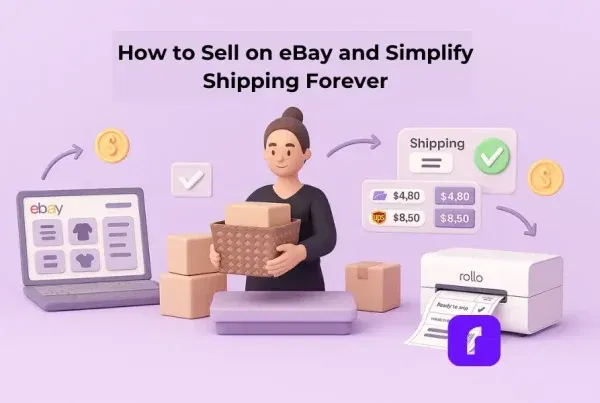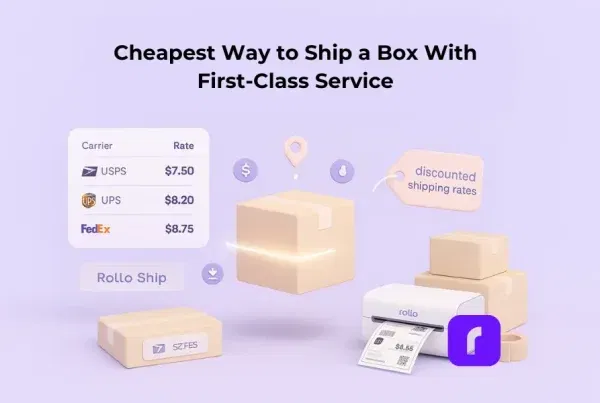Let’s face it: running eCommerce order fulfillment for an online business isn’t a walk in the park. Between juggling inventory management, processing orders, and keeping customers happy, it’s easy to feel overwhelmed. But here’s the kicker – today’s shoppers aren’t just looking for great products. They’re on the hunt for brands that care about the planet too.
That’s where an eco-friendly order fulfillment process comes in. It’s not just a buzzword; it’s a smart way to boost your brand and keep Mother Nature smiling.
In this article, we’ll dive into how you can make your fulfillment process greener, smoother, and more cost-effective. We’ll cover everything from sustainable packaging to tech that’ll make your life easier (hello, Rollo printers!). So, grab a coffee, and let’s explore how you can turn every shipment into a brand-boosting, earth-loving masterpiece.
Jump to a Section
Understanding The eCommerce Order Fulfillment Process
Before we jump into the eco-friendly stuff, let’s break down what the ecommerce order fulfillment process actually is.
In simple terms, it’s everything that happens from the moment a customer clicks “buy” to when they’re unboxing their goodies at home.
The key parts of order fulfillment are:
- 📦 Inventory management: Keeping track of what you’ve got in stock.
- 📋 Order processing: Picking, packing, and getting orders ready to ship.
- 🚚 Shipping: Getting those packages out the door and to your customers.
Sounds straightforward, right? But here’s the thing – how you handle these steps can make or break your eCommerce business. Do it well, and you’ll have customers singing your praises. Mess it up, and… well, let’s just say those one-star reviews aren’t fun for anyone.
Choosing the Right Order Fulfillment Services: DIY or Outsource?
Now, you’ve got two main options when it comes to order fulfillment: doing it yourself (in-house fulfillment) or outsourcing to a dedicated fulfillment center. Both have their pros and cons, so let’s break it down.
In-House Fulfillment: The DIY Approach

Pros:
- 📦 You’re in control of everything
- 🎨 Can add personal touches easily
- 🚀 Great for an eCommerce business just starting out
Cons:
- ⏰ Can be time-consuming
- 🏠 You’ll need space to store inventory
- 🔄 Scaling up can be challenging
Third Party Fulfillment Center: Letting the Pros Handle It
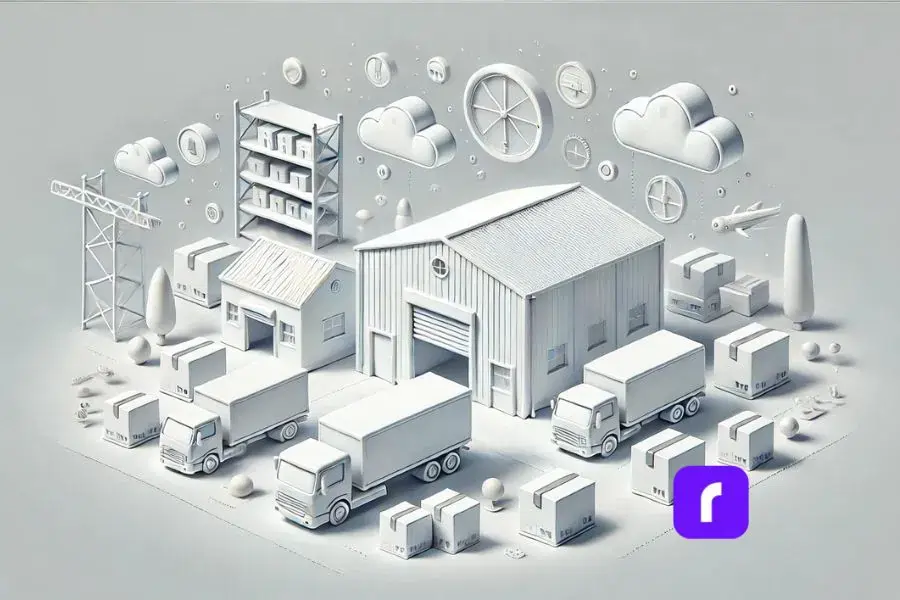
Pros:
- ⏳ Frees up your time for other aspects of your eCommerce business
- 💰 Can be more cost-effective as you grow
- 🛠️ Access to advanced technology and expertise
Cons:
- 🕹️ Less control over the order fulfillment process
- 💸 Order fulfillment services can be pricey
- 🌱 Might not align with your brand’s eco-friendly goals
So, which is better? It really depends on your business. If you’re just starting out and want to keep costs low, in-house fulfillment might be your best bet. But if you’re growing fast and struggling to keep up with orders, partnering with a reliable third party fulfillment center could be a game-changer.
When choosing a fulfillment center, keep these factors in mind:
- 📈 Scalability: Can they grow with your business?
- 💲 Cost: How do their fees stack up against your budget?
- ⏱️ Reliability: Do they have a track record of getting orders out on time?
- 🌿 Eco-friendliness: Do they offer sustainable packaging options?
Remember, your eCommerce fulfillment process doesn’t have to be set in stone. As your business grows, you can always switch things up.
Tech Talk: How Gadgets Can Make Your Fulfillment Greener
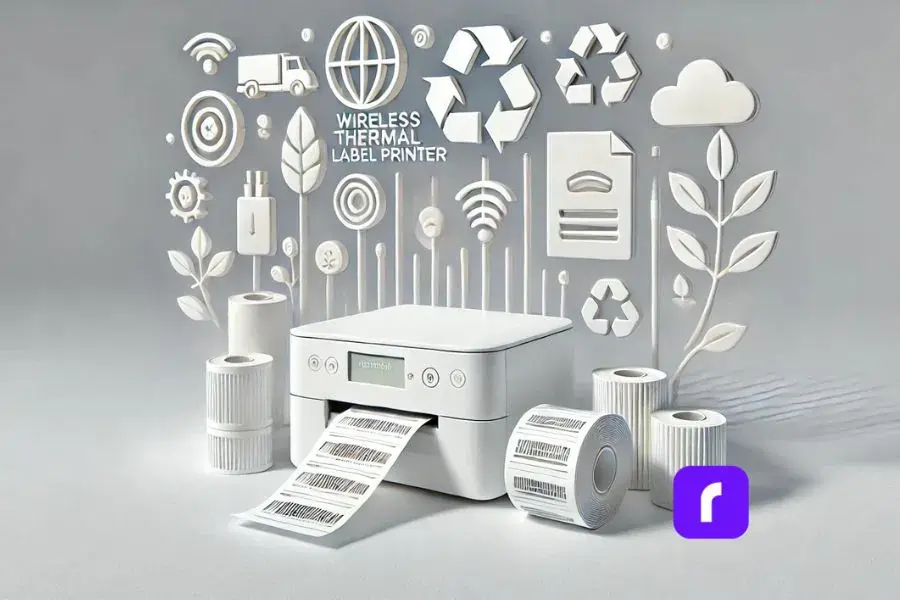
Now, let’s talk tech. The right tools can make your eCommerce fulfillment process smoother, faster, and – you guessed it – more eco-friendly. And no, you don’t need a degree in rocket science to use them.
One game-changer for small businesses? Wireless label printers like those from Rollo. These nifty devices can print shipping labels on demand, which means:
- ♻️ Less waste: You print exactly what you need, when you need it.
- 🖨️ No more ink cartridges: Thermal printing means no more tossing empty cartridges in the trash.
- 💡 Energy efficiency: These printers use less power than traditional models.
Here’s a quick rundown of how tech can make your fulfillment greener:
| Feature | Description |
|---|---|
| Thermal Label Printer | Quick, efficient label printing without ink or toner |
| Rollo Ship App | Centralized platform for weighing packages, comparing rates, and scheduling pickups |
| Carrier Integration | Partnerships with UPS, FedEx, USPS for convenient shipping options |
| Package Weighing | Accurate weight measurement for precise shipping costs |
| Eco-Friendly Solutions | Thermal printing reduces waste; sustainable shipping options available |
| Automated Order Processing | Streamlined order management and label creation |
| Real-Time Tracking | Track shipments and manage deliveries efficiently |
| Customization | Custom labels for branding and personalized messages |
| Pickup Scheduling | Schedule carrier pickups directly from the app |
These features not only streamline your order fulfillment process but also support eco-friendly practices, making your eCommerce operations more sustainable and efficient.
But it’s not just about printers. A good inventory management system can help you avoid overstocking (which often leads to waste) and ensure you’re using materials efficiently.
Here’s a quick rundown of how tech can make your fulfillment greener:
- 🤖 Automated picking systems: These can reduce errors and minimize the need for re-shipping (and all the packaging that comes with it).
- 🌿 Choosing eco-conscious carriers: Partner with UPS and FedEx, who are reducing their carbon footprints through fleet efficiency and alternative fuel vehicles.
- 📧 Digital invoicing: Cut down on paper waste by sending receipts and invoices electronically.
The best part? Many of these tech solutions are surprisingly affordable for small businesses. It’s not about replacing your whole system overnight – even small changes can make a big difference.
Common Challenges in Eco-Friendly eCommerce Order Fulfillment
Let’s be real – going green isn’t always a walk in the park. There are some hurdles you’ll need to jump, but don’t worry, we’ve got your back. Here are some common challenges and how to tackle them:
Challenge 1: Managing Inventory Without Overstock
Overstock is the arch-nemesis of sustainable business. It ties up your cash, takes up space, and often leads to waste. But how do you keep enough stock without going overboard?
Solution: Use data to your advantage. Evaluate your sales channels for patterns, consider seasonal trends, and use inventory management software to help you predict what you’ll need. Start small and adjust your fulfillment strategy as you go – it’s better to occasionally run out of an item than to be stuck with excess stock.
Challenge 2: Finding Affordable Eco-Friendly Packaging
Let’s face it – sustainable packaging often costs more. But before you throw in the towel, consider this:
Solution: Start small. You don’t need to overhaul everything at once. Begin with simple swaps like paper tape instead of plastic, or use boxes made from recycled materials. As for those Rollo label printers we mentioned? They use thermal printing, which means no ink cartridges to dispose of. Small changes add up!
Challenge 3: Handling Returns Sustainably
Returns are a fact of life in ecommerce, but they can be a real headache for eco-conscious businesses.
Solution: Make your return policy clear to reduce unnecessary returns. When returns do happen, try to salvage and reuse packaging materials where possible. And here’s a pro tip: include clear, easy-to-follow return instructions with each order to minimize mistakes and reduce the chance of items being sent back and forth multiple times.
Challenge 4: Balancing Speed and Sustainability
Customers want their orders fast, but the quickest shipping methods aren’t always the most eco-friendly.
Solution: Be upfront with your customers. Offer a slightly slower, more eco-friendly shipping option at a discount. You might be surprised how many people are willing to wait an extra day or two if it means helping the environment (and saving a few bucks).
Remember, overcoming these challenges is a journey, not a destination. It’s okay to take it one step at a time. The important thing is that you’re making an effort – and trust me, your customers will notice and appreciate it.
Branding Through Fulfillment: Making Every Package Count
Alright, let’s talk branding. Your packaging isn’t just a way to get products from A to B – it’s a golden opportunity to make a lasting impression through your order fulfillment process. And when you do it in an eco-friendly way? That’s when the magic happens.
Custom Labels: Your Secret Weapon
First things first – labels. They’re small, but they pack a punch. With a wireless label printer like Rollo’s, you can create custom labels that scream “you” without screaming at the environment. Here’s why they’re awesome:
- 🎨 Personalization: Add your logo, a fun message, or even the customer’s name.
- 📦 Consistency: Every label looks crisp and professional, boosting your brand image.
- 🔄 Flexibility: Change designs on the fly for seasonal promotions or special events.
Packaging That Tells Your Story
Now, onto the main event – the packaging itself. This is where you can really let your brand personality shine. Here are some ideas:
- ♻️ Use recycled or biodegradable materials: Think cardboard, paper, or even mushroom-based packaging for cushioning.
- 🎨 Get creative with design: Use earth-toned inks or embossing instead of flashy colors.
- ✍️ Include a personal touch: A handwritten note or a small freebie made from sustainable materials can go a long way.
- 🔄 Make it functional: Design your packaging so it can be easily reused or repurposed.
Remember, the goal is to create an unboxing experience that’s memorable for all the right reasons. You want your customers to feel good about their purchase, not guilty about the waste.
The Power of Transparency
Here’s a pro tip: be open about your eco-friendly efforts. Include a small card explaining the sustainable features of your packaging. Or better yet, use that Rollo printer to add a QR code to your shipping label that links to a page about your green initiatives.
By making your commitment to sustainability clear, you’re not just sending a product – you’re sending a message. And that message says, “We care about more than just profits. We care about the planet.”
Scaling a Sustainable eCommerce Order Fulfillment Process
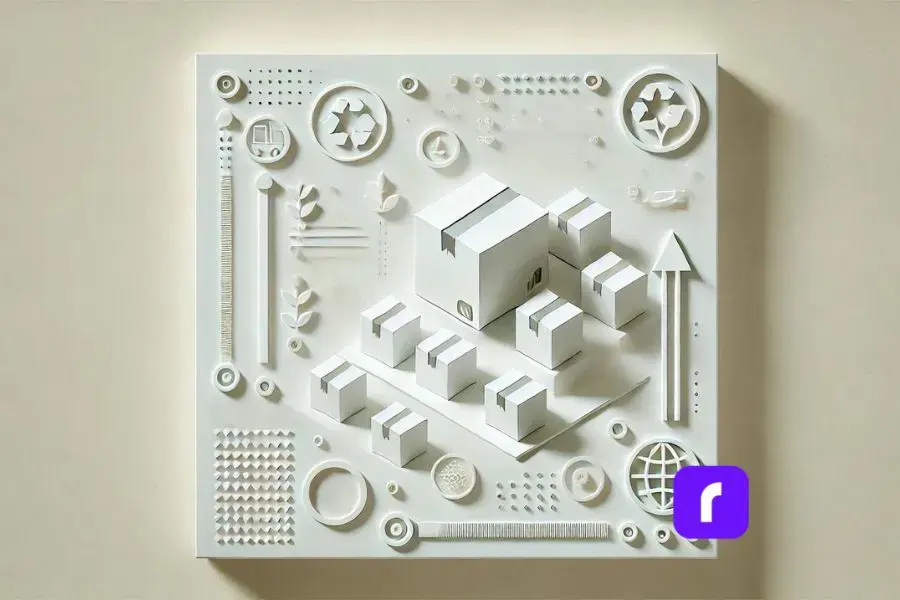
Now, I know what you’re thinking. “This all sounds great, but I’m just a small business. Can I really make a difference?” The answer is a resounding yes! In fact, small businesses are often better positioned to implement eco-friendly practices. You’re more agile, more in touch with your customers, and more able to make quick changes.
Finding the Right Fulfillment Center Partners
As you grow, you might need to look for fulfillment partners. The key is to find a fulfillment center that aligns with your values. Here’s what to look for:
- 🌿 Sustainable practices: Do they use eco-friendly packaging? Energy-efficient warehouses?
- 📝 Transparency: Are they open about their environmental impact?
- 🛠️ Flexibility: Can they accommodate your specific eco-friendly requests?
Don’t be afraid to ask potential partners tough questions about their sustainability practices. A good partner will appreciate your commitment to the environment.
Keeping It Cost-Effective
Going green doesn’t have to break the bank. Here are some budget-friendly ideas:
- 🛒 Bulk buying: Purchase eco-friendly packaging materials in larger quantities to save money.
- 📦 Minimize packaging: Use right-sized boxes to reduce material use and shipping costs.
- 🖨️ Leverage technology: Tools like Rollo printers can help you save on label costs in the long run.
- 🎁 Offer incentives: Give customers a small discount for choosing eco-friendly shipping options.
Remember, sustainability is an investment. It might cost a bit more upfront, but it can lead to loyal customers and a stronger brand in the long run.
Shipping Smarter: Cutting Costs While Staying Green
Shipping – it’s a necessary evil in the world of ecommerce. But here’s the good news: with a bit of clever thinking, you can reduce both your costs and your environmental impact. Let’s dive into some strategies:
Right-Sizing Your Packages
Ever received a tiny item in a massive box? It’s not just annoying for the customer – it’s bad for your bottom line and the environment. Here’s how to avoid it:
- ✉️ Use poly mailers for soft goods: They’re lightweight and take up less space.
- 📦 Invest in a variety of box sizes: This way, you can choose the best fit for each order.
- 🛠️ Consider custom boxes: If you have standard-sized products, custom boxes can minimize wasted space.
Optimizing Your eCommerce Order Fulfillment Process
A streamlined shipping process, often provided by specialized order fulfillment services, isn’t just more efficient – it’s more eco-friendly too. Here’s how to make it happen:
- 📦 Batch your orders: Process and ship orders in batches to reduce the number of pickup trips.
- 🖥️ Use advanced software: shipping solutions like Rollo Ship can help you compare rates and find the most efficient routes.
- 📍 Offer local pickup: For nearby customers, this can eliminate shipping altogether.
The Magic of Accurate Labeling
This is where those Rollo printers really shine. Accurate, easy-to-read labels mean:
- 🚚 Fewer misdeliveries: Less fuel wasted on return trips.
- ⚡ Faster processing: Packages spend less time in transit.
- 🖨️ No wasted labels: Print exactly what you need, when you need it.
Making Returns Work for You
Returns are inevitable, but they don’t have to be a sustainability nightmare. Try these tips:
- 📝 Provide clear product information: Good descriptions and photos can reduce unnecessary returns.
- 📦 Use resealable packaging: This makes it easier for customers to use the same package for returns.
- 📚 Consolidate return shipments: If possible, wait to process returns in batches.
Remember, every small change adds up. You don’t need to implement everything at once – start with what makes the most sense for your business and go from there.
For example, if you’re shipping with UPS, printing accurate UPS labels for shipping can streamline your process, making it easier to manage and track your packages while also supporting eco-friendly practices.
Staying Ahead: Trends and Best Practices in Eco-Friendly Fulfillment
The world of eco-friendly ecommerce is always evolving. Staying on top of the latest trends isn’t just good for the planet – it’s good for business too. Let’s take a look at what’s hot in the world of green fulfillment:
Trend 1: Carbon-Neutral Shipping
More companies are adopting carbon-neutral shipping by offsetting emissions through projects like reforestation. This helps balance the carbon footprint of shipping.
How to implement it: Use online calculators to measure emissions and partner with carbon offset providers. Some carriers offer built-in offset options to simplify the process.
Trend 2: Reusable Packaging Systems
Innovative companies are moving towards reusable packaging, which can be returned and reused, reducing waste and fostering customer loyalty.
How to implement it: Start small by offering incentives for returning packaging in good condition. Design durable packaging that can be repurposed, and communicate these benefits to customers.
Trend 3: Compostable Materials
The rise of plant-based and compostable packaging materials, like cornstarch and seaweed-based options, provides eco-friendly alternatives to traditional plastics.
How to implement it: Replace traditional packaging with compostable options like corrugated paper padding or compostable mailers. Educate customers on proper disposal to enhance eco-friendly practices.
Best Practices for Eco-Friendly Packaging and Shipping
- 📚 Educate your customers: Use your packaging to explain your eco-friendly choices and how customers can properly recycle or compost materials.
- 🤝 Partner with like-minded suppliers: Look for suppliers who share your commitment to sustainability.
- 🔄 Continuously assess and improve: Regularly review your fulfillment process to find new opportunities for sustainability.
- 🗣️ Be transparent: Share your eco-friendly journey with your customers. They’ll appreciate your honesty and efforts.
- 🏷️ Don’t forget the details: Even small things like using water-activated paper tape instead of plastic tape can make a difference.
Remember, becoming more eco-friendly is a journey, not a destination. It’s okay to start small and gradually implement more sustainable practices as you grow.
Final Words
We’ve covered a lot of ground, from the basics of order fulfillment to cutting-edge trends in eco-friendly practices. But here’s the bottom line: sustainable fulfillment isn’t just good for the planet – it’s good for your business too.
By implementing eco-friendly practices, you’re not just reducing your environmental impact. You’re also:
- 🌟 Standing out from the competition: In a sea of brown boxes, your sustainable packaging can make a real impression.
- 🤝 Building customer loyalty: Today’s consumers care about the environment. Show them you care too, and they’ll stick with you.
- 💵 Potentially saving money: While some eco-friendly options might cost more upfront, many can lead to savings in the long run.
- 📈 Future-proofing your business: As environmental regulations tighten, you’ll be ahead of the curve.
Remember, you don’t need to overhaul your entire operation overnight. Start small, perhaps with a label thermal printer to reduce label waste, or by swapping out one type of packaging for a more sustainable option. Test, learn, and grow from there.
The key is to keep your customers in the loop. Let them know about your efforts and invite them to be part of your sustainability journey. You might be surprised at how much they appreciate it.
Curious how sustainable practices can boost your profits too? Our Green Business & The Bottom Line article explores how going green isn’t just good for the planet—it’s smart for your business.
Follow Rollo on:
Frequently Asked Questions About eCommerce Order Fulfillment
📌 Q: What is eCommerce order fulfillment?
💭 A: eCommerce order fulfillment is the process of receiving, processing, and delivering online orders to customers. It includes inventory management, picking and packing products, shipping, and handling returns.rinting labels.
📌 Q: How does the eCommerce order fulfillment process work?
💭 A: The eCommerce order fulfillment process typically involves several steps: receiving and storing inventory, picking and packing products when an order is placed, shipping the order to the customer, and managing returns if necessary.
📌 Q: What are the key components of an effective eCommerce fulfillment strategy?
💭 A: Key components include efficient inventory management, accurate order processing, reliable shipping solutions, and a strong returns management system. Implementing technology and automation can also streamline these processes.
📌 Q: How can I choose the right fulfillment service for my eCommerce business?
Consider factors like cost, scalability, technology, and the company’s track record. Look for a fulfillment service that aligns with your business size, product type, and long-term goals, and offers transparent pricing and reliable service.
📌 Q: How can home-based resellers optimize their order fulfillment process?
💭 A: Home-based resellers can optimize their order fulfillment process by using Rollo’s thermal label printer and Rollo Ship app, which streamline label printing, package weighing, carrier selection, and scheduling pickups—all from home.
📌 Q: How can Rollo’s shipping solutions help home-based resellers choose the best carrier rates?
💭 A: Rollo’s shipping solutions enable resellers to compare rates from top carriers like UPS, FedEx, and USPS directly within the app. This ensures they select the most cost-effective option for each order, optimizing the fulfillment process.

